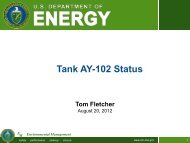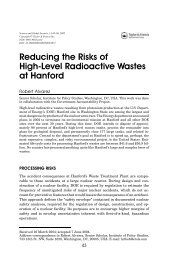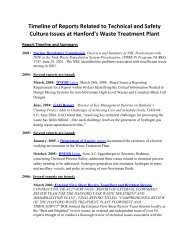Knowing Endangerment - Hanford Challenge
Knowing Endangerment - Hanford Challenge
Knowing Endangerment - Hanford Challenge
Create successful ePaper yourself
Turn your PDF publications into a flip-book with our unique Google optimized e-Paper software.
symptoms: burning skin, persistent rash on face, burning nasal passages, burning, running eyes, dry,<br />
productive or persistent coughs, persistent sore or scratchy throat, damaged vocal cords, instant or<br />
persistent headache, metallic taste in mouth, nosebleeds (one lasting for over 20 minutes), nausea,<br />
vertigo, shortness of breath, and increased heart rates.<br />
The chemical vapor exposure events requiring medical attention since January 2002 occurred in the<br />
following tank farms, followed by the number of separate events that occurred there: C Farm (11);<br />
AW Farm (8); AN Farm (7); A Farm (5); BY Farm (3); AP Farm (2); SX Farm (2); U Farm (3); SY<br />
Farm (1); AX Farm (1); AZ Farm (1); Unknown (1).<br />
B. Chemical Vapor Monitoring - CHG Procedures and Practices<br />
Monitoring in Procedure<br />
CHG uses a variety of equipment to monitor for chemical vapors coming off of the high level waste<br />
tanks, and conducts monitoring activities at several different locations.<br />
CHG conducts monitoring activities at several different locations for chemical vapors coming off of<br />
the high level waste tanks. Headspace monitoring (in the dome or vapor space of the tank) is<br />
performed by lowering a probe into the headspace through a portal to determine the potential for<br />
vapor release and to identify and quantify the chemicals in each tank. 36 Source monitoring is<br />
intended to take place close to the source of vapors, such as at exhausters, pump pits, and electrical<br />
cabinets. The data is to be used by industrial hygiene to determine the highest potential levels at<br />
which employees could be exposed. 37 Area<br />
monitoring, also called breathing zone monitoring,<br />
involves collection and analysis of samples in the<br />
general area where personnel work. 38 Personal<br />
monitoring consists of attaching various sampling<br />
devices to an employee during their work tasks and<br />
evaluating any determinant exposures. 39 CHG‟s new<br />
personal ammonia monitor is an example of personal<br />
monitoring; it is worn on the worker‟s clothing and<br />
changes color according to the intensity of the<br />
ammonia exposure the worker is receiving. 40<br />
CHG uses a variety of equipment to monitor for<br />
chemical vapors coming off of the high level waste<br />
tanks. Each instrument available to perform this monitoring is sensitive to varying numbers of<br />
specific chemicals. 41 No one specific monitor is required to detect a particular class of contaminant.<br />
36 Id. at 47.<br />
37 Id. at 46.<br />
38 Id.<br />
39 Id.<br />
40 CHG, Winds Of Change: Weekly Operational Changes, Mar. 6, 2003, Issue 37, p. 1 [hereinafter Winds of<br />
Change].<br />
41 Upon review of a sample of CHG‟s Direct Reading Instrument Survey records, GAP determined that CHG used at<br />
least 8 separate pieces of monitoring equipment (different pieces on different days for different contaminants) during<br />
November and December 2002.<br />
12







